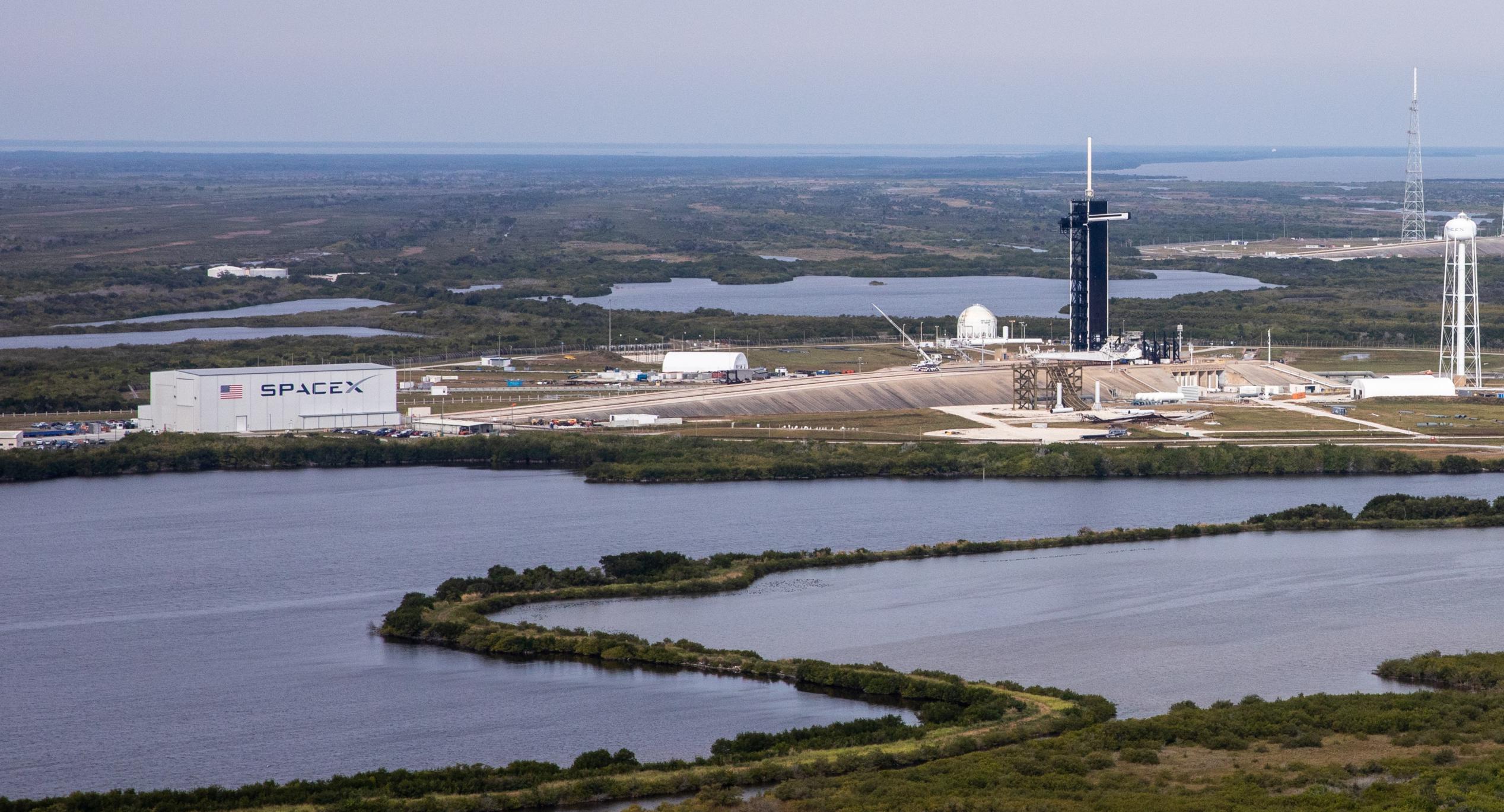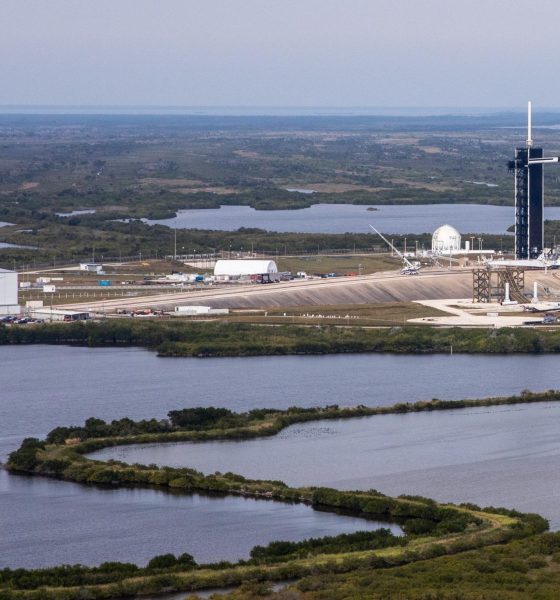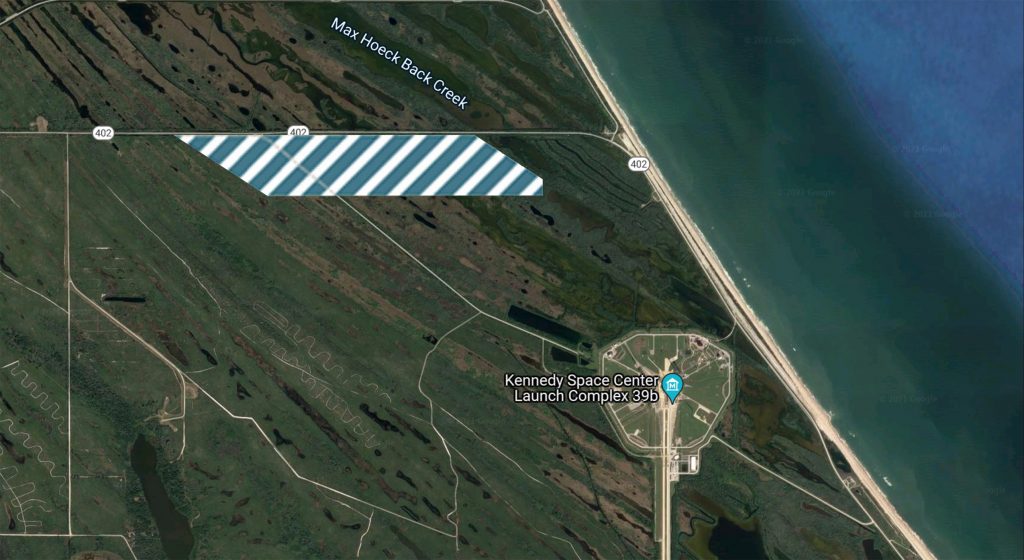

News
SpaceX to replicate Starbase, build multiple Starship launch pads in Florida
Less than two weeks after CEO Elon Musk revealed that SpaceX has restarted construction of a Starship launch site at Kennedy Space Center’s existing LC-39A pad, NASA has revealed the company’s plans for an entirely different Starship launch site just a few miles to the north.
Known as Launch Complex 49 (LC-49) and located where NASA once considered building LC-39C, a third Saturn-class pad to match 39A and 39B, NASA now says that SpaceX aims to develop the site into a dedicated Starship launch pad. The plot of land NASA deemed LC-49 as recently as 2017 sits about 1 mile (1.6 km) northwest of NASA’s LC-39B Space Launch System (SLS) pad and 3 miles (5 km) northwest of LC-39A, which SpaceX has leased since 2014 and launched out of since 2017. Unlike 39A, though, SpaceX has a huge amount of work – and major environmental reviews – ahead of it to turn LC-49 into a site capable of launching a rocket more than twice as powerful as Saturn V.
As of today, “LC-49” amounts to a mostly arbitrary dotted line on a map. Situated a few thousand feet south of the lovingly named Mosquito Lagoon Aquatic Preserve and Canaveral Seashore National Park, the site encompasses a variety of wild wetlands and is fully undeveloped. While substantially wetter, the land SpaceX hopes to develop is actually quite similar to the site that now hosts Starbase’s Starship launch facilities in Boca Chica, Texas. Prior to SpaceX’s arrival, the area was empty coastal mudflats.
To turn such a fragile and unstable area into an orbital launch site, SpaceX trucked in thousands of tons of soil, which then sat in a pile for three years ‘surcharging’ or compressing the ground beneath it. Ironically, while SpaceX did build a relatively small suborbital launch site where it surcharged, the company has built the site’s first orbital Starship launch pad a bit to the east, where no such preparations were made. That bodes well for the speed with which SpaceX could potentially build LC-49 from nothing, though it will likely be significantly more of a challenge.

Because NASA’s proposed LC-49 site is effectively swamp and marshland, SpaceX will have to create the ground any planned Starship launch site will stand on. It’s possible that soil surcharging will be required – and potentially on an even larger scale than what SpaceX did in Boca Chica. However, given that SpaceX ultimately didn’t even use that surcharged land to construct the orbital half of the pad, it’s possible that SpaceX will again be able to make do with less time-consuming construction methods. If SpaceX does more or less replicate an orbital launch site similar to Starbase’s, the pad could be ready to launch just 12-18 months later. NASA and SpaceX will have to complete environmental reviews along the way but given planning work that NASA’s already done over the decades, it’s possible that SpaceX will be able to start building LC-49 well before that process – which could take one or several years – is complete.
No less intriguing is NASA’s implication that SpaceX is simultaneously preparing to expand a facility it leases elsewhere at Kennedy Space Center. Currently used to process and store Falcon boosters, fairings, and upper stages, SpaceX has been clearing a lot beside that hangar that’s about the same size as the entirety of Starbase’s South Texas Starship factory. The obvious implication: SpaceX intends to both build and launch Starships out of multiple Florida launch pads.
Just a few miles south, CEO Elon Musk says that SpaceX has restarted work on a separate Starship launch pad situated on Pad 39A grounds after halting construction last year to focus on South Texas. SpaceX chose to entirely scrap the unfinished launch mount it had built, clearing the site for the construction of a new and improved version of Starbase’s orbital launch site. Altogether, SpaceX is now simultaneously constructing two orbital Starship launch pads (one at Starbase and one at 39A) and planning for the construction of two or three more (a second at Starbase and at least one or two at LC-49).

Elon Musk
Elon Musk’s X will start using a Tesla-like software update strategy
The initiative seems designed to accelerate updates to the social media platform, while maintaining maximum transparency.

Elon Musk’s social media platform X will adopt a Tesla-esque approach to software updates for its algorithm.
The initiative seems designed to accelerate updates to the social media platform, while maintaining maximum transparency.
X’s updates to its updates
As per Musk in a post on X, the social media company will be making a new algorithm to determine what organic and advertising posts are recommended to users. These updates would then be repeated every four weeks.
“We will make the new 𝕏 algorithm, including all code used to determine what organic and advertising posts are recommended to users, open source in 7 days. This will be repeated every 4 weeks, with comprehensive developer notes, to help you understand what changed,” Musk wrote in his post.
The initiative somewhat mirrors Tesla’s over-the-air update model, where vehicle software is regularly refined and pushed to users with detailed release notes. This should allow users to better understand the details of X’s every update and foster a healthy feedback loop for the social media platform.
xAI and X
X, formerly Twitter, has been acquired by Elon Musk’s artificial intelligence startup, xAI last year. Since then, xAI has seen a rapid rise in valuation. Following the company’s the company’s upsized $20 billion Series E funding round, estimates now suggest that xAI is worth tens about $230 to $235 billion. That’s several times larger than Tesla when Elon Musk received his controversial 2018 CEO Performance Award.
As per xAI, the Series E funding round attracted a diverse group of investors, including Valor Equity Partners, Stepstone Group, Fidelity Management & Research Company, Qatar Investment Authority, MGX, and Baron Capital Group, among others. Strategic partners NVIDIA and Cisco Investments also continued support for building the world’s largest GPU clusters.
News
Tesla FSD Supervised wins MotorTrend’s Best Driver Assistance Award
The decision marks a notable reversal for the publication from prior years, with judges citing major real-world improvements that pushed Tesla’s latest FSD software ahead of every competing ADAS system.

Tesla’s Full Self-Driving (Supervised) system has been named the best driver-assistance technology on the market, earning top honors at the 2026 MotorTrend Best Tech Awards.
The decision marks a notable reversal for the publication from prior years, with judges citing major real-world improvements that pushed Tesla’s latest FSD software ahead of every competing ADAS system. And it wasn’t even close.
MotorTrend reverses course
MotorTrend awarded Tesla FSD (Supervised) its 2026 Best Tech Driver Assistance title after extensive testing of the latest v14 software. The publication acknowledged that it had previously criticized earlier versions of FSD for erratic behavior and near-miss incidents, ultimately favoring rivals such as GM’s Super Cruise in earlier evaluations.
According to MotorTrend, the newest iteration of FSD resolved many of those shortcomings. Testers said v14 showed far smoother behavior in complex urban scenarios, including unprotected left turns, traffic circles, emergency vehicles, and dense city streets. While the system still requires constant driver supervision, judges concluded that no other advanced driver-assistance system currently matches its breadth of capability.
Unlike rival systems that rely on combinations of cameras, radar, lidar, and mapped highways, Tesla’s FSD operates using a camera-only approach and is capable of driving on city streets, rural roads, and freeways. MotorTrend stated that pure utility, the ability to handle nearly all road types, ultimately separated FSD from competitors like Ford BlueCruise, GM Super Cruise, and BMW’s Highway Assistant.
High cost and high capability
MotorTrend also addressed FSD’s pricing, which remains significantly higher than rival systems. Tesla currently charges $8,000 for a one-time purchase or $99 per month for a subscription, compared with far lower upfront and subscription costs from other automakers. The publication noted that the premium is justified given FSD’s unmatched scope and continuous software evolution.
Safety remained a central focus of the evaluation. While testers reported collision-free operation over thousands of miles, they noted ongoing concerns around FSD’s configurable driving modes, including options that allow aggressive driving and speeds beyond posted limits. MotorTrend emphasized that, like all Level 2 systems, FSD still depends on a fully attentive human driver at all times.
Despite those caveats, the publication concluded that Tesla’s rapid software progress fundamentally reshaped the competitive landscape. For drivers seeking the most capable hands-on driver-assistance system available today, MotorTrend concluded Tesla FSD (Supervised) now stands alone at the top.
News
Elon Musk’s Grokipedia surges to 5.6M articles, almost 79% of English Wikipedia
The explosive growth marks a major milestone for the AI-powered online encyclopedia, which was launched by Elon Musk’s xAI just months ago.

Elon Musk’s Grokipedia has grown to an impressive 5,615,201 articles as of today, closing in on 79% of the English Wikipedia’s current total of 7,119,376 articles.
The explosive growth marks a major milestone for the AI-powered online encyclopedia, which was launched by Elon Musk’s xAI just months ago. Needless to say, it would only be a matter of time before Grokipedia exceeds English Wikipedia in sheer volume.
Grokipedia’s rapid growth
xAI’s vision for Grokipedia emphasizes neutrality, while Grok’s reasoning capabilities allow for fast drafting and fact-checking. When Elon Musk announced the initiative in late September 2025, he noted that Grokipedia would be an improvement to Wikipedia because it would be designed to avoid bias.
At the time, Musk noted that Grokipedia “is a necessary step towards the xAI goal of understanding the Universe.”
Grokipedia was launched in late October, and while xAI was careful to list it only as Version 0.1 at the time, the online encyclopedia immediately earned praise. Wikipedia co-founder Larry Sanger highlighted the project’s innovative approach, noting how it leverages AI to fill knowledge gaps and enable rapid updates. Netizens also observed how Grokipedia tends to present articles in a more objective manner compared to Wikipedia, which is edited by humans.
Elon Musk’s ambitious plans
With 5,615,201 total articles, Grokipedia has now grown to almost 79% of English Wikipedia’s article base. This is incredibly quick, though Grokipedia remains text-only for now. xAI, for its part, has now updated the online encyclopedia’s iteration to v0.2.
Elon Musk has shared bold ideas for Grokipedia, including sending a record of the entire knowledge base to space as part of xAI’s mission to preserve and expand human understanding. At some point, Musk stated that Grokipedia will be renamed to Encyclopedia Galactica, and it will be sent to the cosmos.
“When Grokipedia is good enough (long way to go), we will change the name to Encyclopedia Galactica. It will be an open source distillation of all knowledge, including audio, images and video. Join xAI to help build the sci-fi version of the Library of Alexandria!” Musk wrote, adding in a later post that “Copies will be etched in stone and sent to the Moon, Mars and beyond. This time, it will not be lost.”








